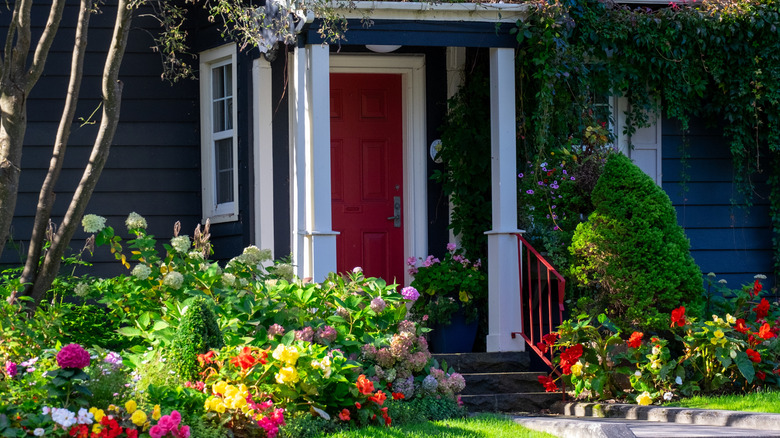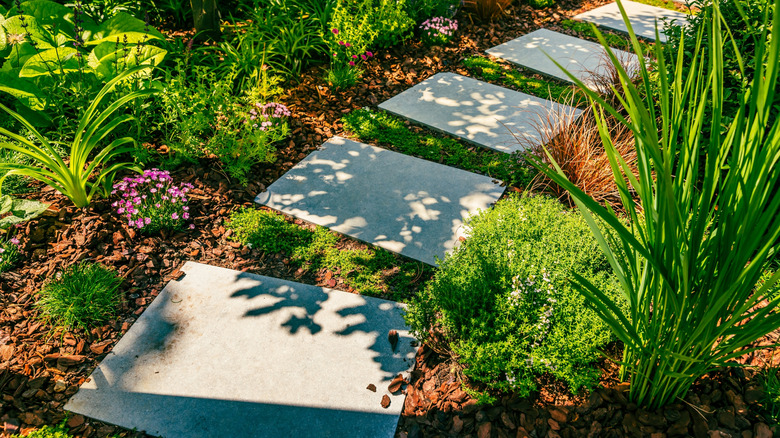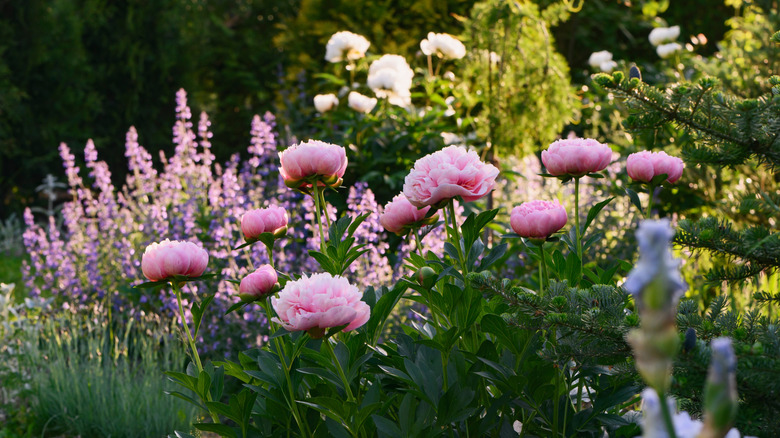The Simplest Way To Give Your Garden A Pro Designer Look Will Cost You Nothing
For homeowners who want to liven up their yards, gardens are the way to go. Adding flowers, bushes, and other plants can completely transform a space. Depending on what methods and plants you use, it can be a super affordable hobby. Plus, gardens can potentially increase the value of your home. You can achieve a professional garden look without spending money by using mulch.
According to The Young Nonno, a creator, garden coach, and consultant, something as simple as mulch can completely elevate your garden. He exclusively told House Digest that "mulch has so many benefits for both ornamental or edible DIY gardens." Mulch's functional aspects include controlling weeds, keeping soil moist, and battling erosion. But it can also serve an aesthetic purpose. The Young Nonno stated that mulch "creates contrasts for gardens that are lower-maintenance, cleaner looking, and more visually appealing." For example, if you have a garden full of colorful flowers, adding dark mulch can give them that extra pop.
Mulch comes in a variety of types including grass clippings, wood chips, and even leaves. To choose the best type of mulch for your garden, consider what benefits you want out of it. Once selected, you don't always need to purchase mulch from a store. Instead, The Young Nonno suggested that you "get resourceful with materials you already have." For example, run a lawnmower over and then spread out fallen leaves, or reuse old décor like straw bales. When using mulch, though, he recommended "plac[ing] a layer of landscape fabric down on the ground" to improve its effectiveness.
Tips for designing your garden with a professional eye
In addition to using mulch as a way to create contrast, The Young Nonno suggested considering how you can use a variety of materials to give your garden depth. As he exclusively told House Digest, "A professional designer will know when and where to mix materials for the best look." One simple element that can make your garden look more put together is installing a path around it. Plus, garden paths are a perfect DIY project that will fit in any yard. You can DIY a stackable retaining wall to serve as a focal point or to add height, too. You can also add tall plants or man-made structures like trellises or pergolas for height.
When designing your garden, The Young Nonno also recommended planning for its mature size. This allows you to fully understand how your plants will look with each other, but also how much room they need. You can use free online tools to help you. While planning, think about your garden throughout the year, too. The Young Nonno pointed out that "long lasting colors or unique textures" that hold up throughout the seasons mean that "the garden isn't only enjoyed a few months a year." To accomplish this, consider adding plants that bloom in the cold like Algerian Iris (Iris unguicularis) or Pansies (Viola x wittrockiana), and limiting the amount of plants you have for a budget-friendly solution.
Perennial plants are another budget-friendly way to achieve a professional look
Picking what plants to use in your garden can be a daunting task. But The Young Nonno recommended simplifying it by prioritizing perennials. As he exclusively told House Digest, "These are lower-maintenance, tend to be more friendly to pollinating insects, and are a one-time purchase." In addition, he noted that you can often dig up and move plants as they grow or if you decide to redesign. Perennial plants that are perfect for your garden include the daylily (Hemerocallis), catnip (Nepeta cataria), and coneflower (Echinacea).
Don't just buy any plant, though. Consider factors like your hardiness zone, soil type, and how much sun your garden receives. If you want a low maintenance space, opt for ones that require less attention. All this will help you further narrow down the list and ensure you pick plants that are appropriate for your garden. To save yourself money, The Young Nonno recommends shopping for perennials towards the end of season when things go on sale. "As long as they have a few weeks in the ground to establish, they will survive and thrive for many years," he explained.


